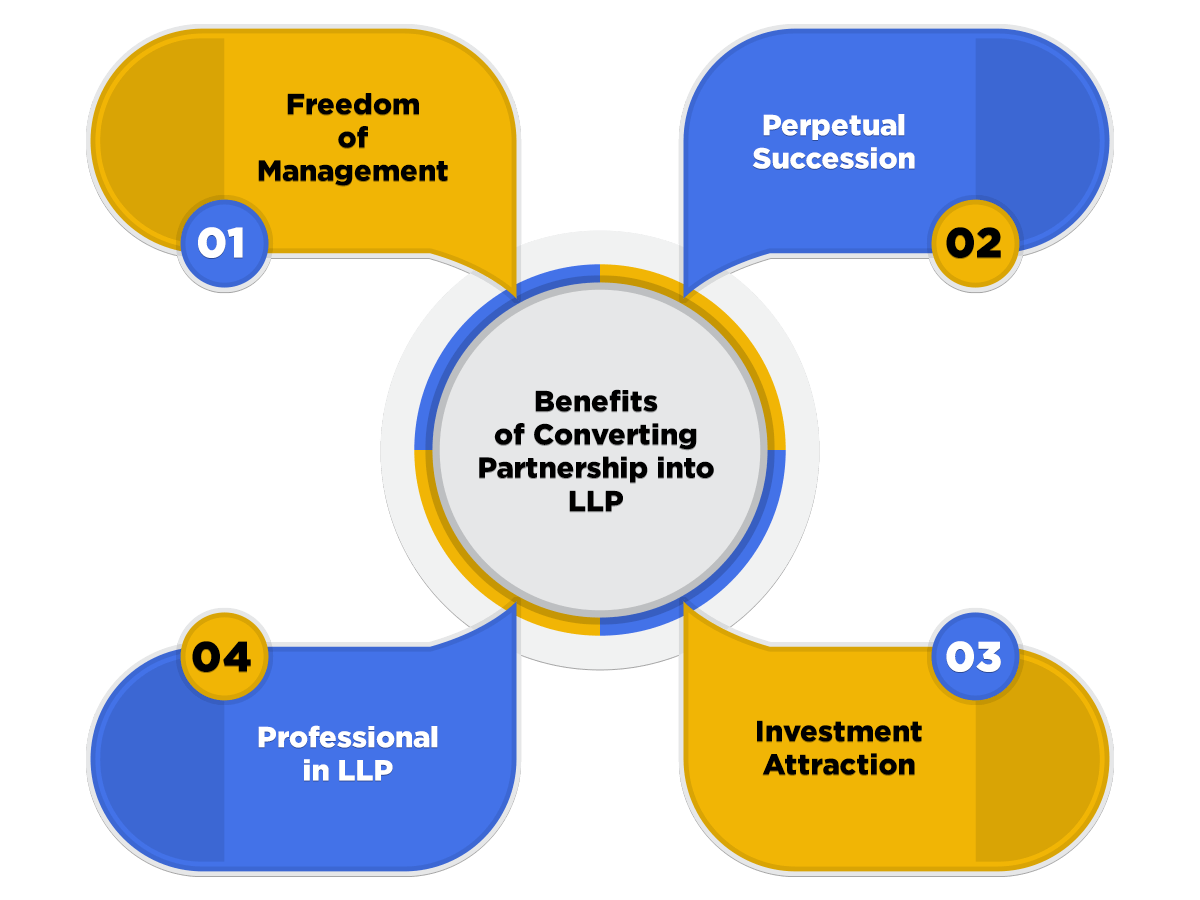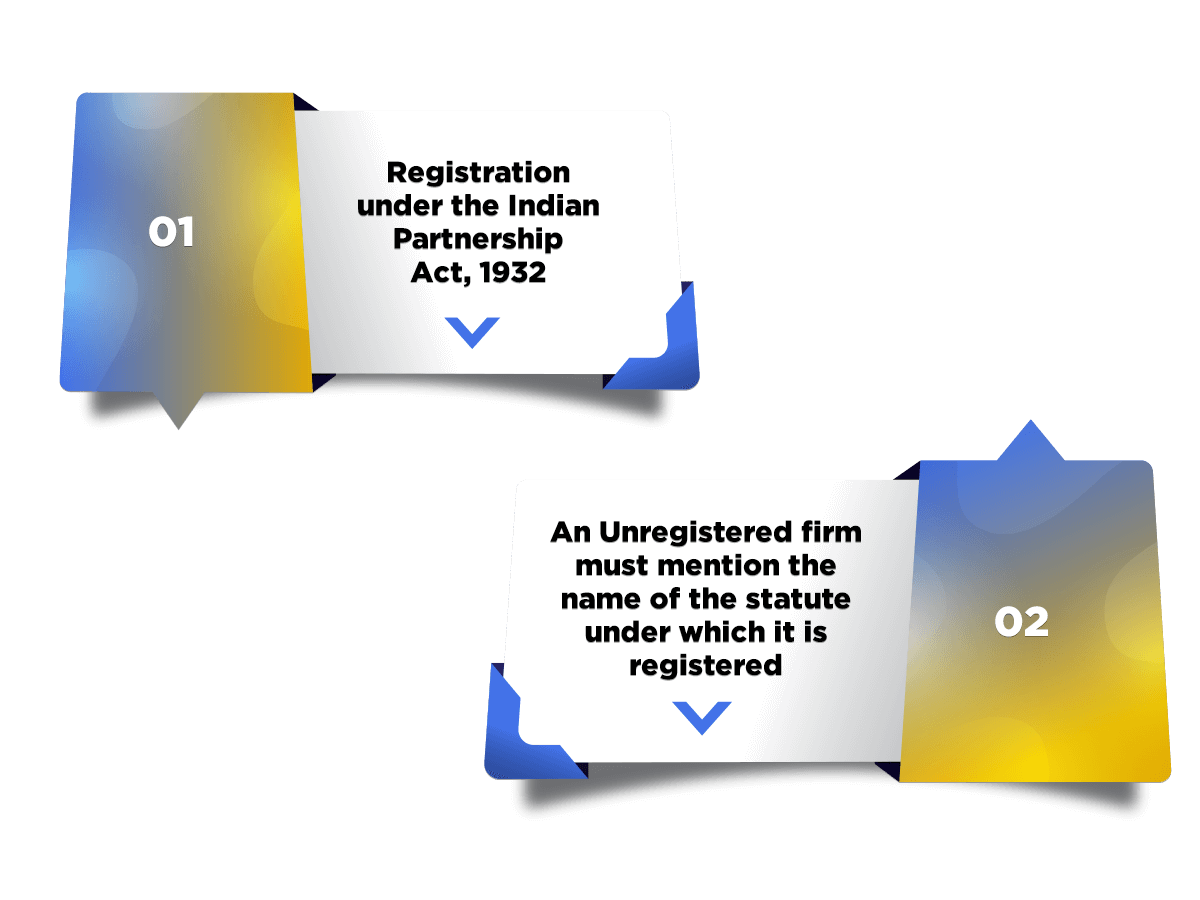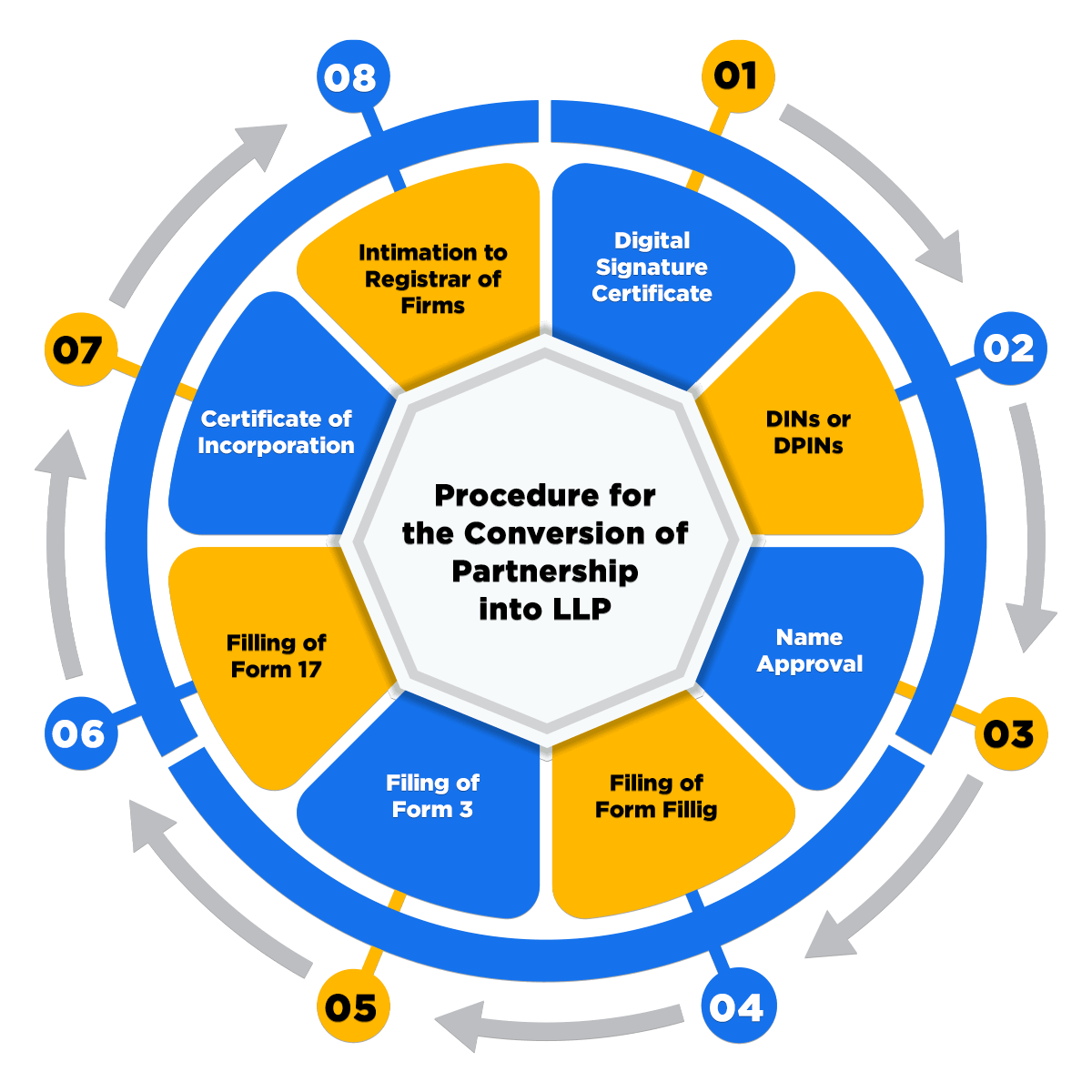Overview of Conversion of Partnership into LLP
The concept of Limited Liability Partnership has enjoyed an upper hand over the traditional Partnership structure. An LLP is a separate legal entity and combines the benefit of a Private Company and Partnership Firm. It means that this business format provides flexibility in the internal control and operations of a firm, an area where a Partnership lacks. Therefore, the conversion of Partnership into LLP is considered to be a good business choice to secure the rights and liabilities of partners.
Concept of Partnership Firm
In India, a partnership firm is a business structure carried on by two or more individuals. It is based on the principal and agent relationship and is governed by the provisions of the Indian Partnership Act, 1932.
A Partnership Deed is an agreement between the partners of the firm. It contains details like the nature of the firm, right and liabilities of partners and their profit-sharing ratios, to name a few.
A partnership firm is not a separate legal entity. It means that the partners of this business format do not enjoy the feature of limited liability.
Concept of Limited Liability Partnership Firm
A Limited Liability Partnership (LLP) is an alternative business format which provides the benefit of limited liability to its partners. It also permits the partners to organize their internal business environment like a partnership firm.
An LLP agreement acts as the basis for a Limited Liability Partnership. It includes the information of assets and liabilities of a firm, along with the rights and duties of partners.
An LLP is a separate legal entity, i.e. the partners of an LLP firm enjoys limited liability. Therefore, an LLP is known as a hybrid of a partnership firm and private company. However, the concept of an LLP is different from a Limited Liability Company.
Benefits of Converting Partnership into LLP
The benefits of converting a partnership firm into LLP are as follows:

- Freedom of Management
The partners of an LLP are given flexibility to carry out operations and day to day affairs.
- Perpetual Succession
An LLP is not affected by the death or exit of the partners due to its Perpetual Succession.
- Investment Attraction
Venture Capitalists and Foreign Investors consider LLPs as a beneficial Investment Opportunity. This is because an LLP has the features of corporate structure and organization flexibility.
- Professional in LLP
Professionals of several disciplines can work together in an LLP.
Criteria for the Conversion of Partnership into LLP

In India, the criteria for the conversion of a partnership firm into an LLP can be summarised as:
- A Partnership Firm must be registered under the provisions of the Indian Partnership Act, 1932.
- A firm not registered under the Act must mention the name of the statute under which it is registered.
Procedure for the Conversion of Partnership into LLP

The steps involved in the procedure for the conversion of partnership into LLP are as follows:
- Digital Signature Certificate
All the partners in a Partnership Firm need to obtain Digital Signature Certificate. It is required for filling up of several Forms.
- DINs or DPINs
All the partners of a partnership firm need to get DIN or DPIN. DIN is a unique number granted by the Central Government. A DIN or DPIN is issued only once and has lifetime validity.
- Name Approval
The partners need to apply for the Name reservation of the proposed LLP with the Ministry of Corporate Affairs. All the partners must obtain name approval before converting a partnership firm into LLP. They need to file Form- 17 (for conversion) and SRN for the Name Reservation (RUN) of LLP.
- Filing of Form Fillip
Now, the partners need to submit forms for the Incorporation of LLP. If the partners do not have DIN, then they can apply for DIN (Maximum 2) in the Form- Fillip. The partners also need to attach the following documents with the form:
- Name of the Proposed LLP;
- DSC (Digital Signature Certificate) of Designated Partners;
- Capital of the Proposed LLP;
- Contribution of the Proposed Designated Partners;
- Phone No. and E-Mail address of Proposed Partners;
- Voter Id Card/ Driving License/ Passport of Proposed Partners;
- Latest Utility Bill of the Registered Office (Not older Than 2 Months);
- Proof of Registered Office (Index-2/ Sale Deed/ Allotment Letter/ Rent Agreement/ Possession Letter/);
- PAN details of Designated Partners;
- Bank Statement of Designated Partners;
- Subscriber Sheet as well as Consent;
- Address Proof of Registered Office including the NOC (No-Objection Certificate) of the Owner;
- Proposed Main Object;
- Details of a Company or LLP if the Designated Partner is a Director or Partner of any other LLP or Company.
- Filing of Form 3
The partners need to file Form 3 concerning the information contained in the Limited Liability Partnership Agreement. They also need to attach the original copy of the LLP agreement as well. The Particulars of an LLP Agreement are as follows:
- Name of the LLP;
- Name of the Designated Partners;
- Total number of Partners;
- Capital Contribution by each Partner;
- Profit sharing ratios;
- Rules governing the LLP;
- Rights and Duties of each Partner.
- Filling of Form 17
The partners need to file Form 17 as an Application for the Conversion of Partnership Firm into LLP. This form comprises partners declaration and needs to be digitally signed by every partner. Further, the form needs to be certified by a Company Secretary, Chartered Accountant or Cost Accountant. The partners also need to attach the following documents:
- Statement of Consent from the partners of the firm;
- Duly Certified Statement of Assets and Liabilities of the firm;
- Copy of Acknowledgement of the latest Income Tax Return;
- List of all the Secured Creditors;
- Consent to convert from all the Secured Creditors.
- Certificate of Incorporation
After the conversion of Partnership into LLP, the Registrar grants a certificate of incorporation of LLP. It means that all the assets, interests, liabilities, rights, privileges, etc. of the firm are transferred to the LLP. However, any license or permit issued to a firm will not directly be transferred to the LLP. That means a new permit or license may be required.
- Intimation to Registrar of Firms
The partners of a firm must inform the ROF about the conversion of Partnership into LLP. They need to file Form 14 which includes all the details of an LLP, within 15 days from the date of registration. Further, the partners need to attach the following documents:
- Copy of the Certificate of Incorporation;
- Copy of the documents submitted with form Fillip.
Summarised Difference between LLP and Partnership
|
Basis |
Partnership Firm |
Limited Liability Partnership |
|
Separate Legal Entity |
No |
Yes |
|
Liability |
Unlimited Liability |
Limited Liability |
|
Books of Accounts |
Not mandatory. |
Must be prepared as per the provisions of the LLP Act, 2005. |
|
Number of Members |
Banking Business: Maximum 20 Any other Business: Maximum 10. |
No upper limit on the maximum number of designated partners. |
|
Digital Signature Certificate (DSC) |
No such requirement |
All the designated partners of an LLP must mandatorily have Digital Signature Certificates. |
Liability of Partners before Conversion of Partnership into LLP
Every partner is severally and jointly liable for the liabilities of the firm which were incurred prior to such conversion. However, if any partner discharges their obligation, then they will be indemnified by the LLP.
Frequently Asked Questions
A Partnership Firm needs to consist of the same number of partners that were present in the original Partnership.
Yes, it is compulsory for a Partnership Firm to have the same number of partners at the time of Conversion.
The partners of a firm can reserve an LLP name by filing an online form. According to law, partners can give a maximum of six names in a preferential order to reserve anyone. The Registrar may also ask to re-submit the application with a different name. The same is possible when the given name does not fall under the ambit of uniqueness, relevancy, etc.
No, there is no minimum amount specified to form an LLP.
The amount contributed by each designated partner will be disclosed in an LLP Agreement.
The term DIN stands for Director Identification Number. It is a unique number allotted by the MCA to Individuals on the application made which permits an individual to be a Director in a Company or LLP.
The concept of DPIN or Designated Partner Identification Number does not exist anymore regarding the incorporation of LLP.
All the partners of an LLP must be above 18 years and competent to enter into a contract. Also, all the proposed Designated Partners must have DIN.
There are no restrictions regarding the citizenship or residency of a Partner. That means Foreign Nationals, Foreign Companies and LLPs can incorporate an LLP in India. However, they must have at least one Designated Partner as the resident of India.
An LLP Agreement is an agreement executed by all the partners after the Incorporation of an LLP. This agreement specifies all the clauses concerning business; including the role, rights, duties, and obligation of partners.
An LLP agreement must be filed within thirty days of the issuance of a Certificate of Incorporation. However, in case of failure, an additional fee of Rs 100 per day will be charged until the date of filing.
The basic aim behind any conversion is to maintain the brand identity in the Market. For incorporating an LLP under the original name, it is necessary to attach a valid proof. The term valid proof denotes a document that corroborates the claim of use of the brand name by the firm.
The Ministry of Corporate Affairs (MCA) is responsible for registering an LLP firm in India. In contrast, the Registrar of Firms (ROF) is authorised to register a Partnership Firm.
No, an LLP cannot have more or less partners than the actual Partnership Firm.
Any change in the number of partners can only be made after conversion.
The main benefits of the process of conversion are Freedom of Management, Perpetual Succession, Investment Attraction, and Professionalism.
The term criterion includes registration under the Partnership Act 1932.
Yes, an unregistered partnership can convert into an LLP by mentioning the name of the statute under which it is registered.
A Partnership Deed is an agreement between the partners of the firm. It contains details like the nature of the firm, right and liabilities of partners and their profit-sharing ratios, to name a few.
A Limited Liability Partnership permits the partners to organize their internal business environment like a partnership firm.
Every partner is severally and jointly liable for the liabilities of the firm which were incurred prior to such conversion. However, if any partner discharges their obligation, then they will be indemnified by the LLP.


